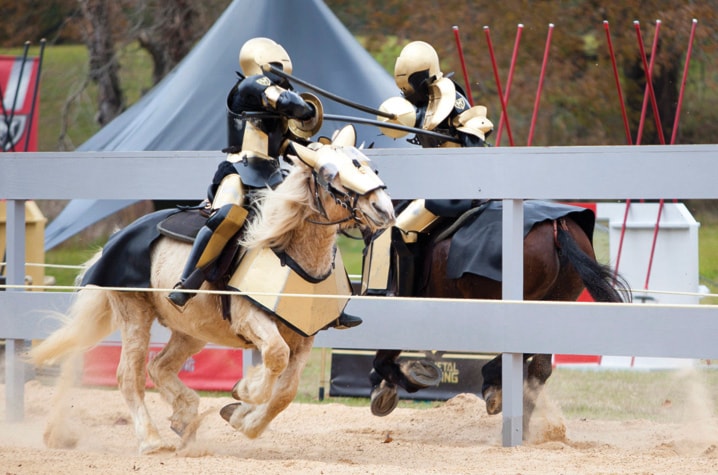TORONTO — An extreme sport from the Middle Ages will be undergoing a renaissance if a Canadian jousting champion has anything to do with it.
Shane Adams, who has 17 international jousting championships under his belt, is living his childhood dream of becoming a knight. The full-contact jouster and coach is host and executive producer of Full Metal Jousting, which premieres Wednesday on History Television.
“Full Metal Jousting is the rebirth of the most extreme sport in the world,” Adams said during a recent visit to Toronto.
“Jousting was the Super Bowl of sports back in the 15th and 16th centuries. Why not bring back the most extreme sport there ever was and show the world that man and horse work together as a team?”
He hopes the show will take off and that jousting will become so popular that spectators will be able to view it live throughout North America.
Adams, 41, grew up on a horse farm in Acton, Ont., west of Toronto, and got his start doing theatrical jousting at Medieval Times.
“But after three years I realized I wasn’t living my true childhood dream of being a knight. Instead, I was a knight in shining polyester and tinsel. I wanted to be that true knight in shining armour.”
He left the dinner theatre, created his own travelling show called the Knights of Valour and performed at festivals and events across Canada.
In 1997, he visited the first international jousting championships in North America held at Estes Park, Colo. He wasn’t planning to compete, and ended up borrowing a horse, armour and lance.
“Three days later I came back to Canada with a broken wrist, a couple of broken bones in my hand, a couple of fractures in my ribs and the world jousting championship title,” said Adams of the bout, where he managed to unseat reigning world champion Phillip Humphries of Nottingham, England.
For the TV show Full Metal Jousting, shot in Jackson, Miss., Adams teamed up with Pilgrim Films and Television, the production company of Craig Piligian, who was co-executive producer of Survivor and helped boost the Ultimate Fighting Championship with The Ultimate Fighter.
History Television put up the award money.
“It’s surprising what people will sign up for when there’s a $100,000 prize at the end of it,” Adams noted.
Some 600 potential candidates tried out for the show, of which 30 were chosen to take part in an intense boot camp led by Adams. From there, he picked the 16 Americans featured in the first season of Full Metal Jousting.
“Even though these guys were tough it was surprisingly easy to come up with the 16 contestants because they started dropping out like flies,” Adams said.
None of the 16 had done full-contact jousting, although they’d done such things as theatrical jousting, bull riding, horse training, show jumping, stunts and firefighting — or were former members of the Marines Corps.
The rules of jousting are simple, the execution is not, Adams said. Competitors require expert riding, timing and guts, and the type of disciplined riding required is difficult.
Imagine sitting astride a 900-kg war horse, dressed in 23 to 45 kg of armour with narrow five-millimetre eye slits while holding a 3.5-metre lance and charging at roughly 30 km/h at an opponent.
Jousters are struck on a license plate-sized panel (referred to as a “gridded grand guard”) that is affixed to the left shoulder of their armour.
“It’s all about hitting a small target with maximum force,” Adams said.
“You could take two of the biggest defencemen in Canada in the NHL today, have them skate full speed to check each other at centre ice. That collision pales in comparison to the amount of force that these guys face while riding their 2,000-pound war horse at 20 miles an hour against the same opposing force.
“And all of that energy is all condensed down to an inch and a half thickness on the end of that lance. Bam! These guys are taking hits of well over 1,000 pounds of force . . . .
“This sport will put a guy in the dirt.”
They earn one point for a hit, five points if they break a lance and 10 points if they unhorse their opponent. A head strike nets a five-point loss. At the end of the 10 episodes the winner takes the $100,000 prize.
The audience is in for plenty of thrills and shudders. If you’re squeamish, be warned: there is blood.
Adams said he was mindful of keeping participants as safe as possible and he put them through their paces before they even mounted a steed. To get an inkling of what it feels like to be hit by a lance the contestants, wearing armour, were knocked down with a battering ram and hit by a metal baseball bat.
The horses wear plenty of protection, with their chests and rumps covered and a plastic shield around their eyes to deflect any flying shrapnel when the solid wooden lances shatter. Adams said the horses, which include Percherons, Friesians and Andalusians, “enjoy the sport of what they were originally bred to do.”
While the first season of Full Metal Jousting is dominated by men, there were many female applicants, though none made the cut.
“But it’s not to say that a female doesn’t have what it takes to be a full metal jousting champion. Of course they do,” Adams says.
“There are actually more female equestrian enthusiasts than what there are male, so give the sport a chance and I bet that in one season or another you will see a female competing amongst the men.”
